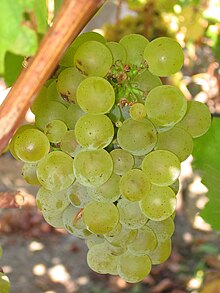| Sauvignon blanc | |
|---|---|
| Grape (Vitis) | |
 Ripe Sauvignon blanc grapes | |
| Color of berry skin | Blanc |
| Species | Vitis vinifera |
| Also called | Sauvignon jaune, Blanc Fume (France), Muskat-Silvaner (Germany & Austria), Fumé Blanc, Sav Blanc (Australia) and other synonyms |
| Origin | France |
| Notable regions | |
| Notable wines | Sauternes, Sancerre |
| Hazards | Powdery mildew, oidium, black rot, and Botrytis cinerea |
| VIVC number | 10790 |
Sauvignon blanc (French pronunciation: [soviɲɔ̃ blɑ̃] ) is a green-skinned grape variety that originates from the city of Bordeaux in France. The grape most likely gets its name from the French words sauvage ("wild") and blanc ("white") due to its early origins as an indigenous grape in South West France.[1] It is possibly a descendant of Savagnin. Sauvignon blanc is planted in many of the world's wine regions, producing a crisp, dry, and refreshing white varietal wine. The grape is also a component of the famous dessert wines from Sauternes and Barsac. Sauvignon blanc is widely cultivated in France, Chile, Romania, Canada, Australia, New Zealand, South Africa, Bulgaria, the states of Oregon, Washington, and California in the US. Some New World Sauvignon blancs, particularly from California, may also be called "Fumé Blanc", a marketing term coined by Robert Mondavi in reference to Pouilly-Fumé.
Depending on the climate, the flavor can range from aggressively grassy to sweetly tropical. In cooler climates, the grape has a tendency to produce wines with noticeable acidity and "green flavors" of grass, green bell peppers and nettles with some tropical fruit (such as passion fruit) and floral (such as elderflower) notes. In warmer climates, it can develop more tropical fruit notes but risks losing much aroma from over-ripeness, leaving only slight grapefruit and tree fruit (such as peach) notes.[2]
Wine experts have used the phrase "crisp, elegant, and fresh" as a favorable description of Sauvignon blanc from the Loire Valley and New Zealand.[3][4] Sauvignon blanc, when slightly chilled, pairs well with fish or cheese, particularly chèvre. It is also known as one of the few wines that can pair well with sushi.[5]
Along with Riesling, Sauvignon blanc was one of the first fine wines to be bottled with a screwcap in commercial quantities, especially by New Zealand producers. The wine is usually consumed young and does not particularly benefit from aging, as varietal Sauvignon blancs tend to develop vegetal aromas reminiscent of peas and asparagus with extended aging. Dry and sweet white Bordeaux, including oak-aged examples from Pessac-Léognan and Graves, as well as some Loire wines from Pouilly-Fumé and Sancerre are some of the few examples of Sauvignon blancs with aging potential.[2]
The first Friday in May is International Sauvignon Blanc Day.[citation needed]
- ^ MacNeil, Karen (2001). 'The Wine Bible. Workman Publishing. p. 52. ISBN 1-56305-434-5. Retrieved 18 May 2021.
- ^ a b Wine & Spirits Education Trust "Wine and Spirits: Understanding Wine Quality" pp. 6-9, Second Revised Edition (2012), London. ISBN 9781905819157.
- ^ Karen MacNeil. The Wine Bible, p. 268, Workman Publishing 2001. ISBN 1-56305-434-5.
- ^ Materman, "Stuff of legends: Marlborough Sauvignon blanc."
- ^ Robert Joseph and Margaret Rand. KISS Guide to Wine, DK Pub 2000. ISBN 0-7894-5981-7.